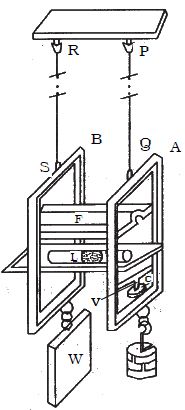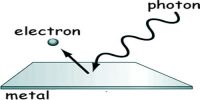The Searle’s apparatus consists of two rectangular steel frames A and B as shown in Figure. The two frames are hinged together by means of a frame F. A spirit level L is provided such that one of its ends is pivoted to one of the frame B whereas the other end rests on top of a screw working through a nut in the other frame.

The bottom of the screw has a circular scale C which can move along a vertical scale V graduated in mm. This vertical scale and circular scale arrangement act as pitch scale and head scale respectively of a micrometer screw.
The frames A and B are suspended from a fixed support by means of two wires PQ and RS respectively. The wire PQ attached to the frame A is the experimental wire. To keep the reference wire RS taut, a constant weight W is attached to the frame B. To the frame A. a weight hanger is attached in which slotted weights can be added. To begin with, the experimental wire PQ is brought to the elastic mood by loading and unloading the weights in the hanger in the frame A four or five times, in steps of 0.5 kg. Then with the dead load, the micrometer screw is adjusted to ensure that both the frames are at the same level. This is done with the help of the spirit level. The reading of the micrometer is noted by taking the readings of the pitch scale and head scale. Weights are added to the weight hanger in steps of 0.5 kg upto 4 kg and in each case the micrometer reading is noted by adjusting the spirit level.
If ∫ is the original length and r the mean radius of the experimental wire, then Young’s modulus of the material of the wire is given by:
q = (F/A) / (dl/∫) = (F/πr2) / (dl/∫)
so, q = F∫/πr2dl











